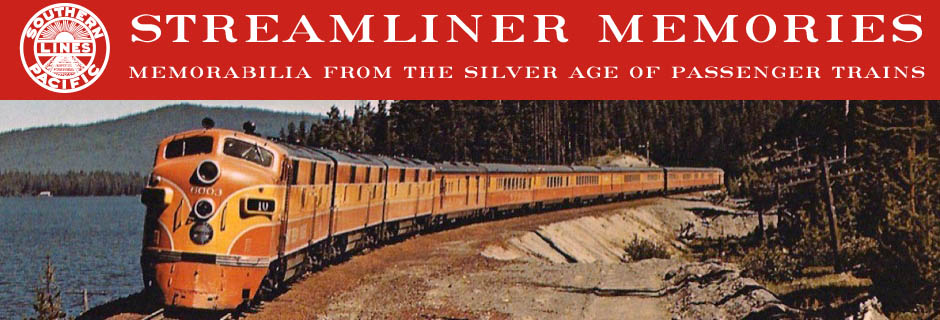Here’s another timetable contributed by Ellery Goode. All of the timetables provided by Mr. Goode are from 1954 through 1956, which were the peak years of streamlined trains in the United States. The railroads were still buying new passenger cars, particularly dome cars, and were responding to declining ridership by eliminating heavyweight trains such as the California Limited and Los Angeles Limited.
 Click image to download a 21.5-MB PDF of this timetable.
Click image to download a 21.5-MB PDF of this timetable.
The passenger business was booming for the Atlantic Coast Line, which during the winter had eight daily trains heading south from New York City (via PRR to DC and RF&P to Richmond): three to the east coast of Florida, two to the west coast, one to Jacksonville, one to Savannah, Georgia, and a coach-only mail train to Florence, South Carolina. Two of the New York-Miami trains took just 24 hours each way — an average of nearly 58 mph — and the other about a half hour longer. The back cover of this timetable advertises that the faster trains were just speeded up, as they had previously required 24-1/2 hours. The shorter times were achieved by running trains at 100 mph over much of the route between Richmond and Jacksonville.
Page 3 says ACL had made its timetables easier to read by replacing “the cumbersome, eyestraining timetable of yore” with “a well-designed modern version.” The main improvement for passengers was that each train was covered by its own timetable, so people didn’t have to look at timetables with seven or eight columns of trains in each direction (though the multiple-column timetable was still included). For historians, the big advantage is that the timetables list the actual consists of each train rather than just an indication that trains had coaches and/or sleeping cars.
For example, the East Coast Champion consisted of one 56-seat coach, a sleeper with four bedrooms, four compartments, and two drawing rooms, three sleepers with 10 roomettes and six bedrooms, a sleeper-lounge with six bedrooms, the diner, a 52-seat coach, five 54-seat coaches, a tavern-lounge car, and another 10-roomette, 6-bedroom car. I suspect the 56-seat coach was the Jim Crow car, meant solely for blacks, which would explain why it was separated from the rest of the coaches. The 52-seat coach was a 54-seat coach with two of the seats reserved for the conductor. The last 10-and-6 sleeper was on the end of the train instead of with the other sleepers because it was added in Washington rather than coming through from New York as the other cars did. That’s a total of 15 cars plus at least one baggage car.
The West Coast Champion was led by a 20-seat coach (the rest of the car was for baggage and a crew dorm), then a 46-seat coach and four 54-seat coaches, a tavern-lounge, a diner, a 54-seat coach and 10-and-6 sleeper that were added in Washington, a six-bedroom-lounge car, and four more 10-and-6 sleepers. That made 15 cars, plus any head-end cars, between Washington and Jacksonville. The train split at Jacksonville with two coaches and two sleepers going to Gainesville, Clearwater, and St. Petersburg and the rest going to Orlando, Tampa, and Sarasota. An extra diner was added to the Jacksonville-St. Petersburg section so passengers would never go hungry.
Unfortunately, the all-Pullman Florida Special didn’t begin operating until December 15, so its equipment isn’t included in this timetable. During the 1950s, it typically consisted of fourteen sleepers (one or two of which were six-bedroom-lounge cars), two diners, and baggage-dormitory cars. Since the Florida Special and Miamian operated only in winter, ACL augmented its fleet by renting cars from Union Pacific, Santa Fe, and other railroads whose high periods were the summer months.
While the Champion and Florida Special were streamlined, other trains, including the New York-St. Petersburg Havana Special and New York-Jacksonville Everglades, still used at least some heavyweight equipment. ACL’s streamlined Pullmans included only all-room sleepers, while any sleeping cars with sections were heavyweights. According to historian Joseph Welsh, ACL was reluctant to replace relatively new heavyweight sleepers with lightweights, which cost it customers to its rival Seaboard Air Line.
The timetable also lists six Chicago/St. Louis-Florida trains and one Cincinnati-Florida train that used Atlantic Coast Line tracks between Montgomery, Atlanta, or Albany, Georgia and Florida and ACL subsidiary Louisville & Nashville tracks north to Louisville, Cincinnati, or Evansville, Indiana. The Dixieland (via C&EI to Evansville), South Wind (via PRR to Louisville), and City of Miami (via IC to Birmingham) each went every third day (so that, between them, there was a daily streamliner from Chicago to Florida. Actually, after December 15, the South Wind and City of Miami were on every-other-day schedules.
These trains were supplemented by the Dixie Flyer (via C&EI), Southland (via PRR), and Seminole (via IC), which were daily but only partially streamlined. There was also the Flamingo, which was L&N/ACL all the way from Cincinnati.

ACL’s reluctance to withdraw its heavyweight equipment sort of echoes SP’s continued use of steam even though its rivals Santa Fe and UP had completely dieselized. Donald Russell justified this by pointing out that using fully depreciated steam locomotives was the economically sensible thing to.